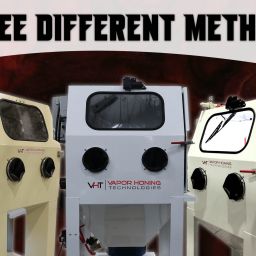The Benefits of an Abrasive Reclamation System in Dry Blast Operations
In the realm of surface preparation, dry blasting stands out as one of the most effective methods. It’s widely used across various industries, including manufacturing, automotive, aerospace, and construction. The process involves propelling abrasive materials against a surface to clean, smooth, or shape it. However, the efficiency and cost-effectiveness of dry blasting can be significantly enhanced with the integration of an abrasive reclamation system. This blog explores the myriad benefits of such a system, emphasizing its impact on operational efficiency, cost savings, environmental sustainability, and workplace safety. Read on to learn more about the benefits of an abrasive reclamation system in dry blast operations.
Check out our full Youtube Video Here https://youtu.be/eLFYMNloFNA?si=YYo78t0uKEQdGtHs
1. Enhanced Operational Efficiency
One of the primary benefits of an abrasive reclamation system is the dramatic improvement in operational efficiency. In a typical dry blast operation, a substantial amount of abrasive material is used, with much of it ending up as waste. An abrasive reclamation system recovers and recycles this material, ensuring it can be reused multiple times. This reduces the frequency of stopping the operation to refill abrasive supplies, thereby minimizing downtime and increasing productivity.
Moreover, modern reclamation systems are designed to automatically separate usable abrasive from debris and dust. This automated separation not only streamlines the process but also ensures a consistent quality of abrasive material, leading to more uniform and reliable blasting results. The automation reduces manual labor, allowing operators to focus on more critical tasks, thereby further enhancing efficiency.
2. Significant Cost Savings
Cost savings are another major advantage of incorporating an abrasive reclamation system. The initial investment in such a system can be substantial, but the long-term financial benefits are undeniable. By reclaiming and reusing abrasive material, companies can significantly reduce their expenditure on new abrasive purchases. Over time, these savings can offset the initial cost of the reclamation system.
Additionally, the improved efficiency and reduced downtime translate to higher throughput and faster project completion times. This allows companies to take on more projects or complete existing ones more quickly, ultimately boosting revenue. The reduction in waste disposal costs is another financial benefit. Since less abrasive material is wasted, there is less need for disposal, which can be both costly and time-consuming.
3. Environmental Sustainability
In today’s world, where environmental sustainability is increasingly important, an abrasive reclamation system offers substantial ecological benefits. The traditional dry blasting process generates a significant amount of waste, contributing to landfill accumulation and environmental degradation. By reclaiming and reusing abrasive materials, the amount of waste generated is drastically reduced.
Furthermore, many abrasive materials are made from natural resources that are becoming increasingly scarce. Reusing these materials helps conserve these resources, promoting sustainable practices within the industry. Some reclamation systems also incorporate dust collection technologies, which capture fine particles that would otherwise be released into the air, reducing air pollution and improving overall environmental health.
4. Improved Workplace Safety
Workplace safety is a paramount concern in any industrial setting. Dry blasting operations can pose various hazards, including exposure to dust and debris, which can lead to respiratory issues and other health problems for workers. An abrasive reclamation system can significantly mitigate these risks.
Reclamation systems often include advanced dust collection and filtration technologies that capture and contain harmful particles. This not only protects the workers but also maintains a cleaner and safer work environment. Additionally, the automation and reduced need for manual handling of abrasive materials lower the risk of injuries associated with heavy lifting and repetitive motions.
5. Consistent Quality and Performance
Consistency in the quality and performance of abrasive materials is crucial for achieving optimal blasting results. Abrasive reclamation systems ensure that the recycled materials maintain their effectiveness by removing contaminants and debris. This results in a more consistent abrasive media, which translates to uniform surface preparation and better adherence of coatings or paints applied afterward.
The ability to control the quality of the abrasive material throughout its lifecycle ensures that each blasting operation meets the required standards and specifications. This consistency is particularly important in industries such as aerospace and automotive, where precision and reliability are paramount.
6. Extended Equipment Life
The use of an abrasive reclamation system can also extend the life of blasting equipment. Abrasive materials can be harsh on blasting machinery, leading to wear and tear over time. By recycling and cleaning the abrasive material, the amount of debris and foreign particles that can cause damage to the equipment is minimized.
Cleaner abrasive material reduces the wear on nozzles, hoses, and other components of the blasting system. This not only extends the lifespan of the equipment but also reduces maintenance costs and the frequency of equipment replacement. As a result, companies can achieve better return on investment for their blasting machinery.
7. Adaptability and Flexibility
Modern abrasive reclamation systems are designed to be highly adaptable and flexible, accommodating various types of abrasive materials and blasting applications. Whether using steel grit, aluminum oxide, glass beads, or other abrasive media, a reclamation system can be tailored to suit specific operational needs.
This adaptability allows companies to switch between different blasting applications without significant changes to the reclamation process. It also enables businesses to explore new materials and techniques, knowing that their reclamation system can handle the changes efficiently. This flexibility is invaluable in a competitive market where innovation and adaptability can provide a significant edge.
8. Compliance with Regulations
Regulatory compliance is a critical aspect of industrial operations. Many industries are subject to stringent regulations regarding waste management, air quality, and worker safety. Implementing an abrasive reclamation system can help companies meet these regulatory requirements more easily.
By reducing waste, minimizing air pollution, and enhancing workplace safety, reclamation systems can ensure compliance with environmental and occupational health and safety standards. This not only avoids potential fines and legal issues but also demonstrates a company’s commitment to responsible and sustainable practices.
9. Competitive Advantage
In a competitive market, any edge can make a significant difference. Companies that adopt abrasive reclamation systems can position themselves as leaders in efficiency, sustainability, and innovation. This can be a strong selling point when attracting new clients or bidding on projects.
Customers are increasingly looking for partners who prioritize environmental responsibility and efficient operations. Demonstrating the use of advanced reclamation technology can enhance a company’s reputation and make it more appealing to environmentally conscious clients and stakeholders.
10. Future-Proofing Operations
The industrial landscape is constantly evolving, with new technologies and practices emerging regularly. Investing in an abrasive reclamation system is a step towards future-proofing operations. As regulations become more stringent and the push for sustainability grows stronger, companies that have already adopted reclamation systems will be better positioned to adapt and thrive.
Additionally, as technology advances, so do reclamation systems. Modern systems are increasingly incorporating smart technologies, such as IoT sensors and AI-driven analytics, to optimize performance and predict maintenance needs. Staying ahead of these trends ensures that companies remain competitive and capable of leveraging the latest advancements to their benefit.
Conclusion
The benefits of an abrasive reclamation system in dry blast operations are manifold, ranging from enhanced operational efficiency and significant cost savings to improved environmental sustainability and workplace safety. By reclaiming and reusing abrasive materials, companies can achieve consistent quality and performance, extend the life of their equipment, and ensure compliance with regulatory standards.
Moreover, the adaptability and flexibility of modern reclamation systems provide a competitive advantage and help future-proof operations against evolving industry demands. In a world where efficiency, sustainability, and innovation are increasingly valued, the integration of an abrasive reclamation system is not just a wise investment but a strategic imperative.
For businesses looking to enhance their dry blasting operations, investing in an abrasive reclamation system offers a clear path to improved performance, reduced costs, and a stronger commitment to environmental responsibility. As industries continue to evolve, those who embrace such technologies will be well-positioned to lead the way into a more efficient and sustainable future. If you are interested in learning even more about the benefits of an abrasive reclamation system in dry blast operations contact our sales team to learn more today
Office: 828-202-5563
Email: info@vaporhoningtechnologies.com
To buy these products and see pricing click here https://vaporhoningtechnologies.com/price-guide/








